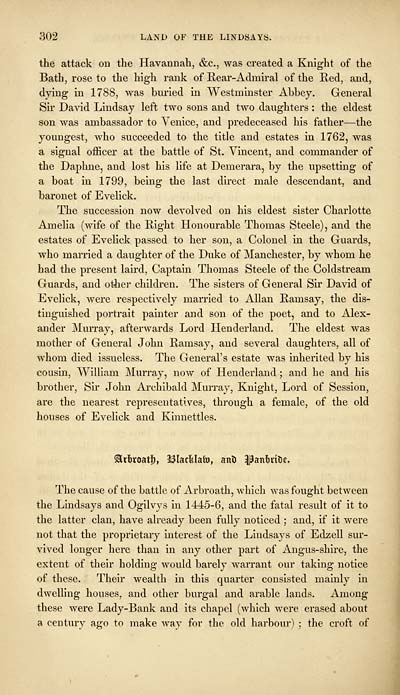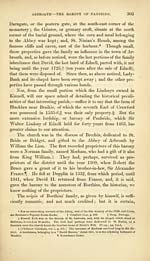Download files
Complete book:
Individual page:
Thumbnail gallery: Grid view | List view

302 LAND OF THE LINDSAYS.
the attack on the Havannah, &c, was created a Knight of the
Bath, rose to the high rank of Hear- Admiral of the Red, and,
dying in 1788, was buried in Westminster Abbey. General
Sir David Lindsay left two sons and two daughters : the eldest
son was ambassador to Venice, and predeceased his father — the
youngest, who succeeded to the title and estates in 1762, was
a signal officer at the battle of St. Vincent, and commander of
the Daphne, and lost his life at Demerara, by the upsetting of
a boat in 1799, being the last direct male descendant, and
baronet of Evelick.
The succession now devolved on his eldest sister Charlotte
Amelia (wife of the Right Honourable Thomas Steele), and the
estates of Evelick passed to her son, a Colonel in the Guards,
who married a daughter of the Duke of Manchester, by whom he
had the present laird, Captain Thomas Steele of the Coldstream
Guards, and other children. The sisters of General Sir David of
Evelick, were respectively married to Allan Ramsay, the dis-
tinguished portrait painter and son of the poet, and to Alex-
ander Murray, afterwards Lord Henderland. The eldest was
mother of General John Ramsay, and several daughters, all of
whom died issueless. The General's estate was inherited by his
cousin, William Murray, now of Henderland ; and he and his
brother, Sir John Archibald Murray, Knight, Lord of Session,
are the nearest representatives, through a female, of the old
houses of Evelick and Kinnettles.
®tfcroatf)» 33Iacfelafo, anJ) ^anltittic.
The cause of the battle of Arbroath, which was fought between
the Lindsays and Ogilvys in 1445-6, and the fatal result of it to
the latter clan, have already been fully noticed ; and, if it were
not that the proprietary interest of the Lindsays of Edzell sur-
vived longer here than in any other part of Angus-shire, the
extent of their holding would barely warrant our taking notice
of these. Their wealth in this quarter consisted mainly in
dwelling houses, and other burgal and arable lands. Among
these were Lady-Bank and its chapel (which were erased about
a century ago to make way for the old harbour) ; the croft of
the attack on the Havannah, &c, was created a Knight of the
Bath, rose to the high rank of Hear- Admiral of the Red, and,
dying in 1788, was buried in Westminster Abbey. General
Sir David Lindsay left two sons and two daughters : the eldest
son was ambassador to Venice, and predeceased his father — the
youngest, who succeeded to the title and estates in 1762, was
a signal officer at the battle of St. Vincent, and commander of
the Daphne, and lost his life at Demerara, by the upsetting of
a boat in 1799, being the last direct male descendant, and
baronet of Evelick.
The succession now devolved on his eldest sister Charlotte
Amelia (wife of the Right Honourable Thomas Steele), and the
estates of Evelick passed to her son, a Colonel in the Guards,
who married a daughter of the Duke of Manchester, by whom he
had the present laird, Captain Thomas Steele of the Coldstream
Guards, and other children. The sisters of General Sir David of
Evelick, were respectively married to Allan Ramsay, the dis-
tinguished portrait painter and son of the poet, and to Alex-
ander Murray, afterwards Lord Henderland. The eldest was
mother of General John Ramsay, and several daughters, all of
whom died issueless. The General's estate was inherited by his
cousin, William Murray, now of Henderland ; and he and his
brother, Sir John Archibald Murray, Knight, Lord of Session,
are the nearest representatives, through a female, of the old
houses of Evelick and Kinnettles.
®tfcroatf)» 33Iacfelafo, anJ) ^anltittic.
The cause of the battle of Arbroath, which was fought between
the Lindsays and Ogilvys in 1445-6, and the fatal result of it to
the latter clan, have already been fully noticed ; and, if it were
not that the proprietary interest of the Lindsays of Edzell sur-
vived longer here than in any other part of Angus-shire, the
extent of their holding would barely warrant our taking notice
of these. Their wealth in this quarter consisted mainly in
dwelling houses, and other burgal and arable lands. Among
these were Lady-Bank and its chapel (which were erased about
a century ago to make way for the old harbour) ; the croft of
Set display mode to:
![]() Universal Viewer |
Universal Viewer | ![]() Mirador |
Large image | Transcription
Mirador |
Large image | Transcription
Images and transcriptions on this page, including medium image downloads, may be used under the Creative Commons Attribution 4.0 International Licence unless otherwise stated. ![]()
| Histories of Scottish families > History and traditions of the land of the Lindsays in Angus and Mearns > (320) Page 302 |
|---|
| Permanent URL | https://digital.nls.uk/94872866 |
|---|
| Description | A selection of almost 400 printed items relating to the history of Scottish families, mostly dating from the 19th and early 20th centuries. Includes memoirs, genealogies and clan histories, with a few produced by emigrant families. The earliest family history goes back to AD 916. |
|---|

